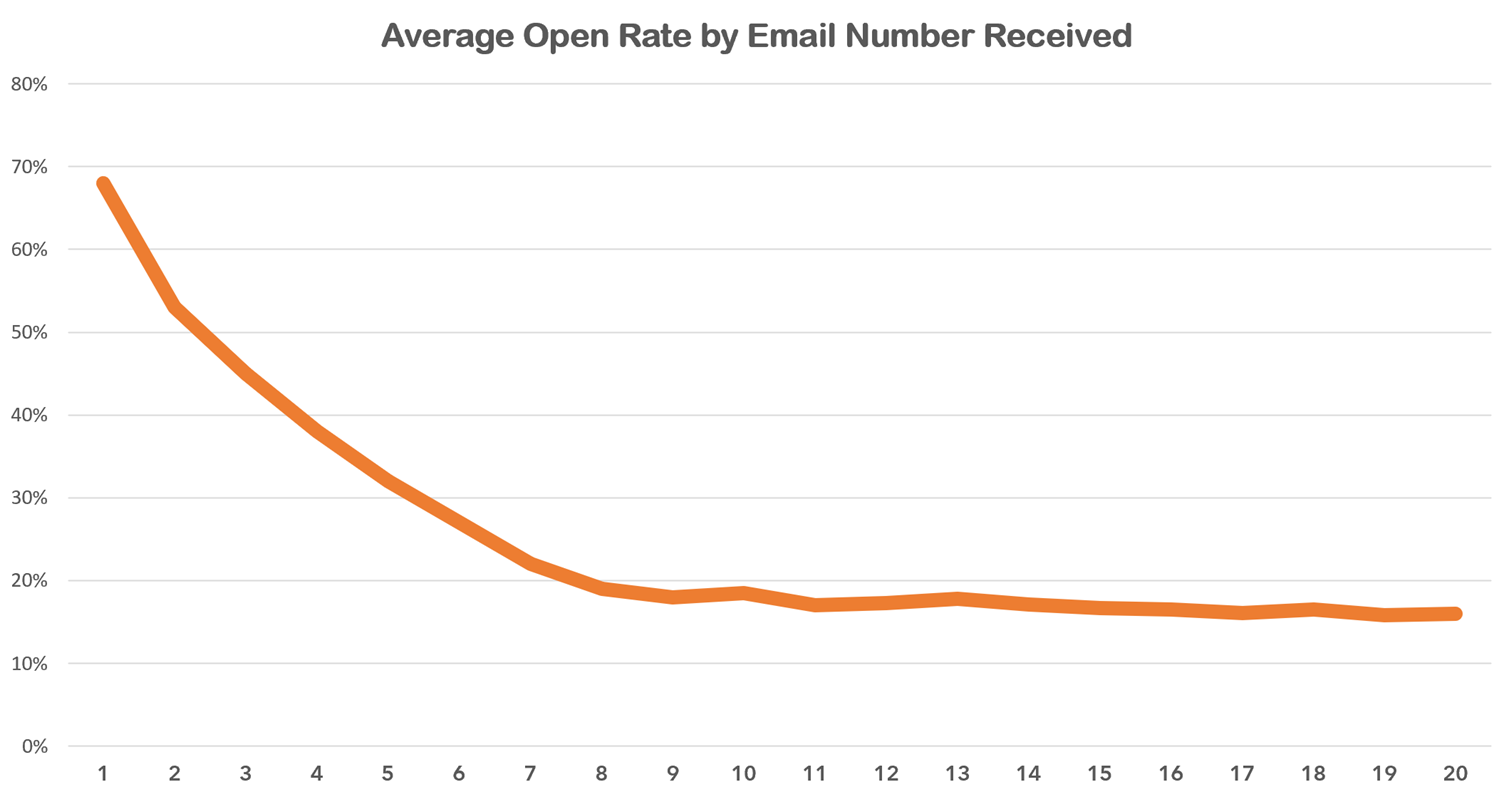How customers's unconscious decisions impact your email marketing
As marketers we tend to overthink how our customers feel, and how they interact with the marketing emails we send them.
We obsess about what goes into the messages and the schedule, order and cadence of messaging.
We’ve designed the campaigns so customers will rationally follow our lovely call-to-action as their way of taking action.
All of this is with the presumption that like us, our customers are making conscious decisions when it comes to choosing what emails to read.
But this isn’t how this works in the real world.
It leads to ideas that aren’t true and backed up with data:
- The subject line is the most important factor in getting the open
- Customers will read all of your email
- They’ll buy what you are promoting in the campaigns
- You can’t send too many or they’ll get fed up and unsubscribe
- They’ll remember what you sent last week so woe betide you dare repeat your messaging
And if those presumptions aren’t true, your email strategy will be far from optimal.
The reality is our customers don’t pay too much attention to the details, and we need to understand we exist in a world where they are getting dozens of marketing emails every day and aren’t waiting for your next email to pop into their promotions folder.
Much of the decision making of whose email to open is down to unconscious decisions, and whether they simply have the capacity to spend time on these emails.
Unconscious Decisions
The only research that seems to exist in the area of what makes a consumer open one email over another is a few surveys that have been run. But these are almost always flawed. They ask questions like ‘what makes you open an email?’ before listing things like ‘Great Offers’ or ‘Relevant Content’.
Respondents are always going to pick those in a survey – you are not going to say you aren’t influenced by a great offer.
But choosing to open an email or not is a bit like brushing your teeth. Both are done on auto pilot; you don’t need to think it through – it’s become entirely an unconscious activity.
Let’s consider how the unconscious mind chooses what to open.
Firstly, if you see a brand you like, and whose emails you regularly find useful then you’ll more likely open this. That’s why your best customers have the best open rates. It’s why testing the ‘From’ name has a much greater impact on open rate than subject lines.
In fact, the likelihood of an individual opening an email is set before you’ve scheduled it in your ESP. If they have found the last few emails they’ve opened to not be of value or interest that will make it far less likely to open. If they have no need for your product or services, they are less likely to open.
You’ll notice I haven’t even talked about subject line as being a driver of opens. This clearly does have an impact, but it is marginal in comparison. Customers look to see who the email is from first, and only if you pass that test will they consider the contents of the subject line.
But some will open even if you have a terrible subject line just because they like you and your brand, or they have had good experiences with your emails before.
Remember - all of this happens in the subconscious. If I look back on the emails I chose to open and the ones I ignored, none of it was me thinking this through rationally, it’s done on instinct.
A non-scientific study
I don’t have the scientific study behind me to justify this so I’m going to use the very non-scientific method of a straw poll of 1 (me!) and try and understand why I open emails from specific brands.
The 2 brands I seem to open the most are:
- The CDP Institute – their emails contain 3 news stories daily about CDPs but also a lot of marketing automation platforms. I open these nearly every day because I know there is nearly always something of interest to me. I don’t think I ever look at the subject line to determine if I’m going to open.
- Screwfix – a UK DIY retailer I have a small obsession with. I’m curious to what they have in the sale, or what the new releases are because I have a strong interest. Again, there is always something new that I find interesting, so I have this unconscious urge to open. Again, the subject line isn’t that important to me. Yet I never buy anything in the email itself, but it reminds me of other things I might need and encourages me to hop on the site where I pop something in my checkout for store collection.
A retailer I shop with what seems like daily (as I’m sure we all do) is Amazon. Looking through my promo emails, I open a reasonable amount of their email. But searching my inbox for which ones I did open -- a pattern emerges – it’s where the subject line must have piqued my interest. Now Amazon being Amazon these tend to be personalised around my search and buying activity. When that personalisation has hit the spot (about 1 in 5 times), I’ve opened but otherwise I’m a bit ‘meh’.
This is probably a symptom of not being that emotionally connected to Amazon. I use it a lot but its convenience more than a real interest. They must work harder to attract my attention on email, but also, I find their emails a bit hit and miss.
Then there are a whole host of brands I never seem to open. I can put those all into 2 buckets:
- Those that I shopped with once but have no need for that product again, so I chose not to open because I’m not interested in the brand
- Those that I have shopped with a few times but their emails are generic rubbish that never have anything of interest in them. I’ve learned that they are not worth my time opening
Even those ones that I open regularly I’ll still miss emails though. Either because I’m too busy or I’m not active on email. Any marketing emails sent to me on a weekend are far less likely to be read by me as I’m just not on email as much then.
And when we have busy promotions folders, even when I am back in my email this has gone so far down the list, I’m not likely to see it. Just like Google placement means if you are not in the top 3 search results you are nowhere, get past probably 8-10 from the top and I won’t be opening.
What happens when customers do open an email?
The next failing that marketers make is thinking your customers actually read your emails and remember what was in them.
Customers don’t read emails, they scan them. So, agonising over individual word choices in multiple paragraphs of copy is a pointless endeavour.
And worrying about including something that you mentioned last week is assuming your customers have memory superpowers.
What actions should we take knowing this?
This is all very well but let’s bring it back to what thinking about unconscious decisions means for the changes we can make to our email marketing.
1. From names and personalities
If we know the first thing that is looked at before the subject line, and that who the sender is, then the ‘from’ name is clearly the most important variable to get right.
We always tend to find that changing to a ‘First name – Company Name’ will give a strong uplift to opens and clicks, typically 20%+ increases. But not forever.
I assume that’s because the freshness and the fact that a person’s name is there appeals to the unconscious mind. We all know that person didn’t actually send the email, but this is an unconscious decision.
But this is why it only works for a short time until you have to change it up again as the mind starts to decide whether emails sent from this ‘from’ name will likely contain something of interest.
On a similar note is to use personalities to deliver your messaging inside the email. Again, we all know they didn’t sit down and send that email from their computer to us but people we like, or have authority are more persuasive than bog standard marketing messages.
2. Relevancy creates long-term openers
Below is a little chart that takes a bit of effort to run, but can be an eye opener into thinking about email engagement.
This plots the very 1st, 2nd, 3rd and so on email received by customers and works out the open rate on it.

You’ll typically see the curve follow this pattern of starting high with the first marketing email you send having the highest open rate, before it tails off and then flatlines.
The flatlining is down to 2 core reasons:
- A natural decline in engagement with your brand over time – the first email is likely to be just after the first purchase
- The realisation from customers that there isn’t anything of interest in these emails you send
It’s only really the 2nd point that you can do anything about and there isn’t some simple action to resolve this.
But if we go back to my email examples and think of my unconscious mindset of ‘there is always something in the email that interests me’. This leads to more fundamental conversations around how you use email as a channel.
Do you load it with lots of low-quality content pushing whatever commercial target you need to hit? Or do you focus on always providing high value, and of course ensuring relevancy?
This chart simply helps explain the downsides of the former strategy to those which insist on email being used to solve short term problems.
3. Emails don’t need to be opened to influence
On our weekly OI calls this seems to be a constant thing we talk about.
As marketers we been taught to measure those who clicked our CTA and went onto buy. But what if the email arriving in the inbox simply reminds them about you and they go on later and buy via Google.
If you think that is far-fetched, we often see brand PPC terms shoot up on email day.
And if you want real evidence keep a hold out cell on your next campaign and compare the purchase rate of those that didn’t open the email to those that didn’t get it (the only caveat here is to compare like for like value segments because your top customers who will spend anyway, are more likely to open the email. Oh, and to minimise the Apple MPP opens try non openers in the first 2 hours of the email).
4. High frequency is needed for when they are busy
Customers are failing to open your emails because they are busy – it’s not a judgement on the quality of the email and its content.
So, get that frequency up. And a great place to start experimenting with this is resending to non-openers.
But here is a caveat – you can’t just increase the frequency with low value emails. As we talked about in point 2, if customers build up a picture in their mind of your emails never having anything of interest in them then you’ll get a lot more list fatigue.
5. Design for scanning
If you know customers don’t read but scan emails you need to design for that. You’ll want design techniques like
- Alternating colour copy in headlines
- Use bullet points and short paragraphs to put messaging into chunks
- Roundels and other techniques for highlighting key messages
- Irregular shapes and patterns that aid the eye to scroll down the page
This isn’t an article on email design and I’m sure plenty have written in-depth guides on this but the clear message here is can you get your key message across in under 2 seconds of scanning.
Final Point
The chances are you already know a lot of this, and are already doing a lot of these actions. But I bet you are finding challenges every day trying to explain others how email really works. This is where I think it’s worth investing the time to change the mindset of our paymasters to free you up to work on things that will make a difference to your email activity.
 Photo by Danil Shostak on Unsplash
Photo by Danil Shostak on Unsplash

 How to resolve AdBlock issue?
How to resolve AdBlock issue? 
 Sean Duffy is founder of Segmentum, an eCRM strategy & implementation agency, and Reignite, a real-time email personalisation platform.
Sean Duffy is founder of Segmentum, an eCRM strategy & implementation agency, and Reignite, a real-time email personalisation platform.